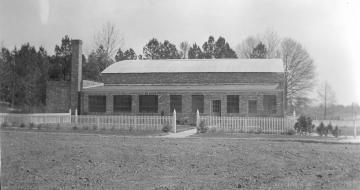In September 1931, William & Mary established a Department of Aeronautics. The department was started by President Julian A. C. Chandler, in conjunction with the Riordan School in New York City. To support the Department, William & Mary, in cooperation with the City of Williamsburg, operated the Williamsburg Municipal Airport. Almost all of the flight activity centered around the Department's instruction, however, the field was open to some commercial and private use. According to the 1933 Colonial Echo yearbook and a 1934 issue of the Alumni Gazette, the flight school was the first ever to be incorporated into the curriculum of an institution of higher learning.

Located 1 mile northwest of William & Mary at Ewell Station (near present day Airport Road), the airport featured two runways , each five hundred feet wide and eighteen hundred feet long, in an L-shaped formation. To support student instruction, a hangar was built in 1931. That building contained airplane storage space, which was sixty by eighty feet with an overhead clearance of sixteen feet. It also housed repair shops, parts storage, a waiting room, restrooms, and administration offices. Modern (at least for that time) fueling service was available at an electrically operated field pit and specification gasoline and oils were kept in stock. Weather information, together with other information provided by the Department of Commerce and the Navy Hydrographic Office were posted daily.
Lieutenant Colonel Earl C. Popp, who taught at the Riordan School, offered his services as a flight instructor to William & Mary students for free, in exchange for the use of laboratory facilities at the College for his students. In addition to Popp, Julian Chandler, Jr. (son of the President) and Yelverton O. Kent served as assistant instructors. Students learned to fly in four different planes, including an open-cockpit Biplane, a Fleet Trainer, a Kitty Hawk, and a Curtis Robin. Alumni from that era recalled that the planes were painted green, gold and silver. Students were required to take part in courses three times a week, with additional laboratory work at the College Airport. Thirty-three students enrolled in that first semester.

After students logged 20 hours of flight time, they were eligible to become private pilots. After three years, the college deemed the cost of insurance and maintenance on the planes too much, and the program was shut down. By its end in 1934, approximately 70 students received aeronautical training and forty-four students qualified for government flight licenses, including at least one woman, Minnie Cole Savage. Popp's method of teaching stressed a psychological observance of the student and his/her reactions to flying, plus the safety factor of quality equipment. The Colonial Echo credited his method as why there had not been an accident in flight work.

The students of the Aeronautics Department formed the Flight Club in 1931. Its mission was to sponsor and arrange programs for the furtherance of aviation interest on campus. It won the Loening Trophy in 1933, with Purdue University taking second place. The Trophy is presented annually to the outstanding all-around collegiate aviation program in the nation. In 1933, the club's membership totaled 19 and was of a selective nature, according to a report by its president, Louis Carner.


On March 14, 1933, Amelia Earhart visited campus and was made an honorary member of the Flight Club. She was the principal speaker at a special convocation held at Phi Beta Kappa Hall, speaking on the topic "Women and Aviation." In her address, she stressed the importance of freedom for women in the selection of careers, predicted the continual advancement in trans-oceanic flights, and spoke of the economic changes which resulted from flying. She also urged any woman who was interested in aviation to pursue and develop her interest with vigor and zeal and stated that women would, in the future, occupy an important and responsible position in aviation. Later in the evening, she attended a dinner hosted by the Flight Club at the Williamsburg Inn. The banquet honored both Earhart and the Club's new pledges.


The College Airport continued to operate, with companies renting the facilities for commercial use. It closed in 1967 due to poor conditions. In 1980, the Board of Visitors sold 30 acres to the City of Williamsburg. The remaining airport property was sold to the city in 1985.
For more information about the Flight School, read Yelverton O. Kent's oral history.

